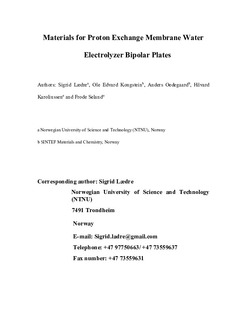| dc.contributor.author | Lædre, Sigrid | |
| dc.contributor.author | Kongstein, Ole Edvard | |
| dc.contributor.author | Ødegård, Anders | |
| dc.contributor.author | Karoliussen, Håvard | |
| dc.contributor.author | Seland, Frode | |
| dc.date.accessioned | 2017-11-14T07:41:56Z | |
| dc.date.available | 2017-11-14T07:41:56Z | |
| dc.date.created | 2017-08-08T10:26:46Z | |
| dc.date.issued | 2017 | |
| dc.identifier.citation | International journal of hydrogen energy. 2017, 42 (5), 2713-2723. | nb_NO |
| dc.identifier.issn | 0360-3199 | |
| dc.identifier.uri | http://hdl.handle.net/11250/2466027 | |
| dc.description.abstract | Titanium based BiPolar Plates (BPPs) are commonly used in Proton Exchange Membrane Water Electrolyzers (PEMWEs) today as they can withstand the harsh operating conditions experienced inside an operating PEM water electrolyzer. In particular, the high anode potential and acidic nature of the PEM is crucial for BPP performance. In this work we expand the investigation of non-coated materials at relevant operating conditions to include molybdenum, 254 SMO, tungsten, AISI 316L, AISI 304L, Inconel 625, niobium and tantalum, in addition to Titanium gr. 2. Pre-designed potentiostatic and potentiodynamic tests at potentials up to 2.0 VSHE were performed in addition to Interfacial Contact Resistance (ICR) and weight loss measurements. Scanning Electron Microscopy (SEM) imaging was conducted to observe morphology changes during the electrochemical tests. Titanium, tantalum and niobium experienced little or no weight change during potentiostatic polarization, while for AISI 304L, AISI 316L and tungsten the measured weight loss was much lower than the weight loss calculated from currents produced. When the potentiostatic test was prolonged for titanium, the ICR was found to increase with time. Auger Electron Spectroscopy measurements confirmed that the increase in ICR for titanium, tantalum and niobium is related to an increased thickness of surface oxides. | nb_NO |
| dc.language.iso | eng | nb_NO |
| dc.publisher | Elsevier | nb_NO |
| dc.rights | Attribution-NonCommercial-NoDerivatives 4.0 Internasjonal | * |
| dc.rights.uri | http://creativecommons.org/licenses/by-nc-nd/4.0/deed.no | * |
| dc.title | Materials for Proton Exchange Membrane water electrolyzer bipolar plates | nb_NO |
| dc.type | Journal article | nb_NO |
| dc.type | Peer reviewed | nb_NO |
| dc.description.version | acceptedVersion | nb_NO |
| dc.source.pagenumber | 2713-2723 | nb_NO |
| dc.source.volume | 42 | nb_NO |
| dc.source.journal | International journal of hydrogen energy | nb_NO |
| dc.source.issue | 5 | nb_NO |
| dc.identifier.doi | 10.1016/j.ijhydene.2016.11.106 | |
| dc.identifier.cristin | 1484742 | |
| dc.description.localcode | This is the authors' accepted and refereed manuscript to the article. Locked until 2 February 2019 due to copyright restrictions. | nb_NO |
| cristin.unitcode | 194,66,35,0 | |
| cristin.unitcode | 194,64,25,0 | |
| cristin.unitname | Institutt for materialteknologi | |
| cristin.unitname | Institutt for energi- og prosessteknikk | |
| cristin.ispublished | true | |
| cristin.fulltext | postprint | |
| cristin.qualitycode | 2 | |

